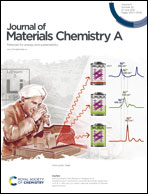One-micron-thick organic indoor light harvesters with low photocurrent loss and fill factors over 67%†
Abstract
Organic photovoltaic cells (OPVs) have great potential for driving indoor electronic devices for internet of things (IoTs). Under indoor illumination, the thick active layer can produce high photocurrent due to the large light-harvesting, whereas the trap states usually dominate the charge recombination in such thick-film devices and limit the largest possible photocurrent. Herein, we adopted a strategy of insulating polymer dilution to suppress the charge trapping states in the indoor organic photovoltaic (IOPV) devices with the different active layer thickness from 140 to 1000 nm. A diluting strategy with 5% insulating polystyrene effectively reduces the trap state density, delivering an excellent fill factor of around 67% and growth of short-circuit current density with increasing the thickness to 1-micron under 2700 K light-emitting diode tube. For the diluted ultra-thick blend, the reduced trap states suppress the exciton quenching at traps, accelerate the dissociation of intra-moiety polaron pairs and improve the transport properties, enabling more photogenerated carriers and low photocurrent loss in ultra-thick devices. This work provides an effective diluting strategy of decreasing trap state density for realizing ultra-thick IOPV devices with high performance and demonstrates the key role of charge trapping in IOPV performance.



 Please wait while we load your content...
Please wait while we load your content...